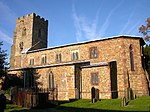Stanford-on-Avon

Stanford-on-Avon is a village in the civil parish of Stanford in West Northamptonshire, England. It lies next to the River Avon, which here forms the county boundary between Northamptonshire and Leicestershire. On the Leicestershire side of the river is Stanford Hall, a historic house. Stanford Reservoir is one mile north of the village. The population is included in the civil parish of Clay Coton. The hamlet's name means 'Stone ford' situated on the River Avon.In a field just north-east of the village there is a stone monument to Percy Pilcher, a 19th century aviation pioneer who died in a glider accident at the location of the monument in 1899.The village was formerly served by Yelvertoft and Stanford Park railway station on the former Rugby and Stamford Railway which closed in 1966. The station is now a private house.Stanford-on-Avon is now the only populated settlement within the civil parish of Stanford. The parish contains the remains of two deserted medieval villages of Downtown and Stanford.
Excerpt from the Wikipedia article Stanford-on-Avon (License: CC BY-SA 3.0, Authors, Images).Stanford-on-Avon
ถนนสุขุมวิท, Bangkok เขตคลองเตย
Geographical coordinates (GPS) Address Nearby Places Show on map
Geographical coordinates (GPS)
| Latitude | Longitude |
|---|---|
| N 52.4023 ° | E -1.1348 ° |
Address
ถนนสุขุมวิท
10330 Bangkok, เขตคลองเตย
Bangkok, Thailand
Open on Google Maps








